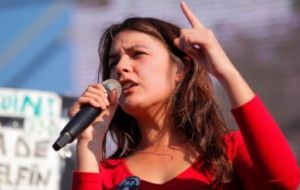MercoPress. South Atlantic News Agency
Violent clashes in Santiago as students-government negotiations break down
 Vallejo accused the government of unprecedented use of force
Vallejo accused the government of unprecedented use of force Chilean students marched in downtown Santiago Thursday, clashing with police and blocking traffic for much of the day, after negotiations with the government over education reforms broke down.
“This has been one of the most violent marches” after four months of demonstrations, newspaper La Tercera quoted Santiago Mayor Pablo Zalaquett as saying.
Chilean police used water cannons and tear gas to break up the student march demanding free public education. A huge deployment of riot police surrounded students in the Plaza Italia, Santiago's traditional gathering place, where student leader Camila Vallejo tried to lead the march while holding a sign saying “United and Stronger,” only to be pummelled by water cannons and forced to retreat by tear gas.
Protesters hurled rocks at police and set blockades ablaze in the streets as officers on horseback chased students onto nearby campuses. Vallejo said officers shot tear gas into their student government offices in “a direct attack against our organization.”
Students occupied the Alameda, one of Santiago's main avenues, by dancing in large numbers, but were blasted with water from police. Small groups managed to elude officers and approach the presidential palace before being beaten back by police.
The regional governor, Cecilia Perez, said 132 people were arrested and 25 officers and five civilians were injured. At least half-dozen journalists were arrested. She called this “lamentable” and said their arrests would be investigated.
Thursday's march was the 37th weekly protest since the movement against Chile's largely privatized education system in began in April, demanding more spending and higher taxes on the wealthy so that quality public education can be free for all.
With both sides accusing the other of intransigence, Chile's government has focused on criminalizing the protests, proposing tough new penalties including up to three years in prison for occupying schools and other public places.
Vallejo called the police crackdown unprecedented, even for a movement that for five months has seen initially peaceful mass marches dissolve into isolated but violent confrontations between hooded demonstrators and helmeted, baton-wielding police.
“We're sure that we represent the great majority of Chileans,” Interior Minister Rodrigo Hinzpeter said Thursday as he defended the government plan to penalize the peaceful occupation of schools and other places, and enable police to demand images taken by photographers and camera crews without a judicial warrant.
Polls show 89% of Chileans support the students' call for reform, and only 30% support President Sebastian Piñera performance. The president finally agreed to let the students sit down with his education minister, Felipe Bulnes, to discuss their core complaint: that private institutions benefit from public funding while public institutions are starved for resources.
Bulnes said the protesters' proposal was regressive and would mean “that the poor subsidize the education of the richest.”
“Neither do we want the poorest to finance the richest, but that the richest finance the poor and middle class. How? Through tax reform,” Vallejo countered.
The government has proposed increasing scholarships for the poorest Chileans, but Vallejo said that won't solve this as long as taxpayer money flows unequally to profit-making institutions
The student federation, known as Confech, will vote Oct. 8 whether to continue talks with the government after its leaders disagreed with Education Minister Felipe Bulnes.
“I’ve told students on numerous occasions that working under the logic of all or nothing, will not lead to progress,” Bulnes said in images transmitted on state television. “They can’t base structural reform on free education for all students.”




Top Comments
Disclaimer & comment rules-

-

-

Read all commentsI seem to remember Argies denouncing the riots in England and claiming that protests in South America were now only peaceful. Just proves how full of it they really are.
Oct 07th, 2011 - 11:39 am 0The only reason there is no bloodshed in Arg is because most of the protets are organized by CFK. They allow them to destroy pubic property and the private property of their enemies. Most of the protests are gov't sponsored, the only one I remember that was big was when a nice white kid from the suburbs was kidnapped and killed. I think his name was Axel. The father at first held vigils then the crowds grew and grew. He was going to run for office and since he had a real grass roots populous base Nestor had him destroyed. They ruined him politically, financially and I am sure physically threatened him and his family.
Oct 07th, 2011 - 01:06 pm 0In Arg these protests are all political theater with most of the protesters bused in, given a choripan and a beer to cheer or destroy on CFK or her minion's whim. It is a crock. The problem is sometimes they get out of control, like when the economy starts to falter, so she better already have a house in Miami to flee to and keep the helicopters ready at Casa Rosada because it is not too far off now.
Pretty Camila Vallejo is becoming more and more a bourgeois specimen.
Oct 07th, 2011 - 01:12 pm 0She needs to be sent urgently to Cuba for a re-education session!
Philippe
Commenting for this story is now closed.
If you have a Facebook account, become a fan and comment on our Facebook Page!